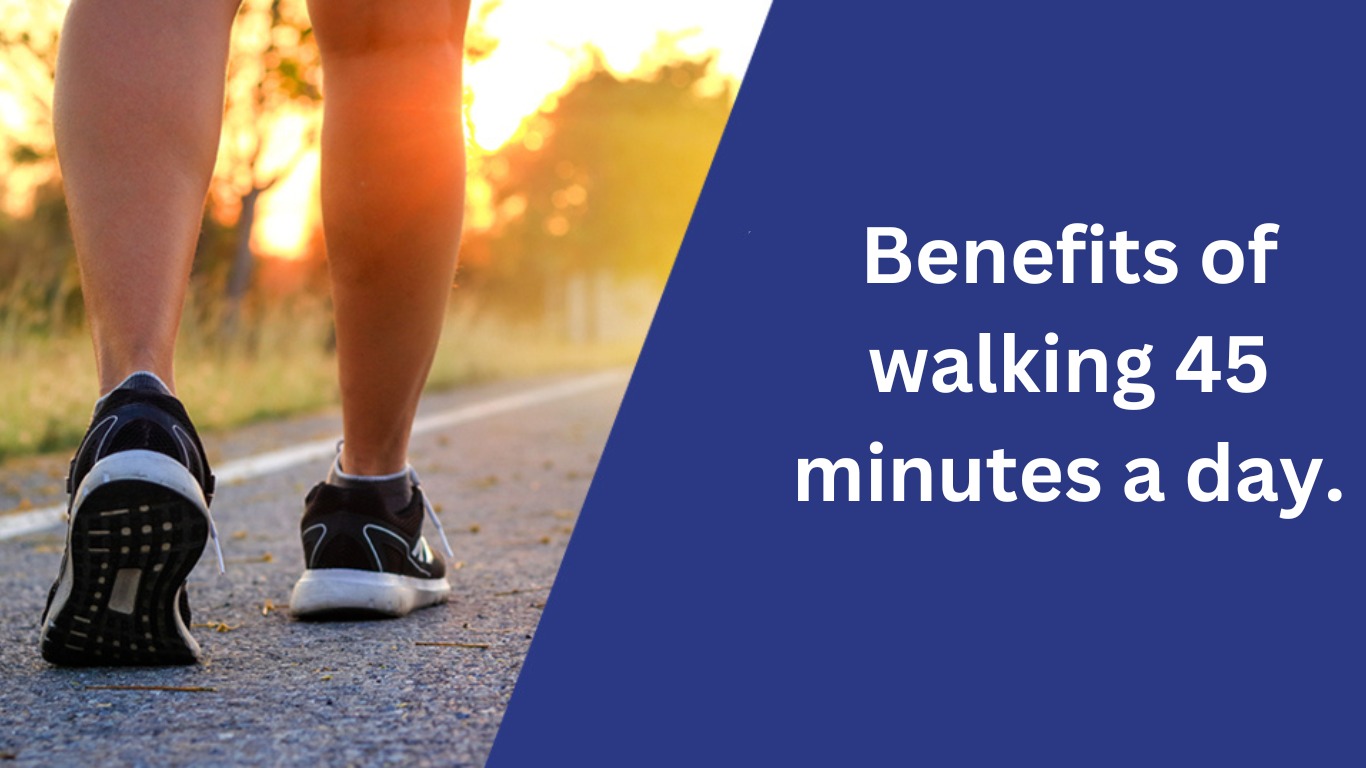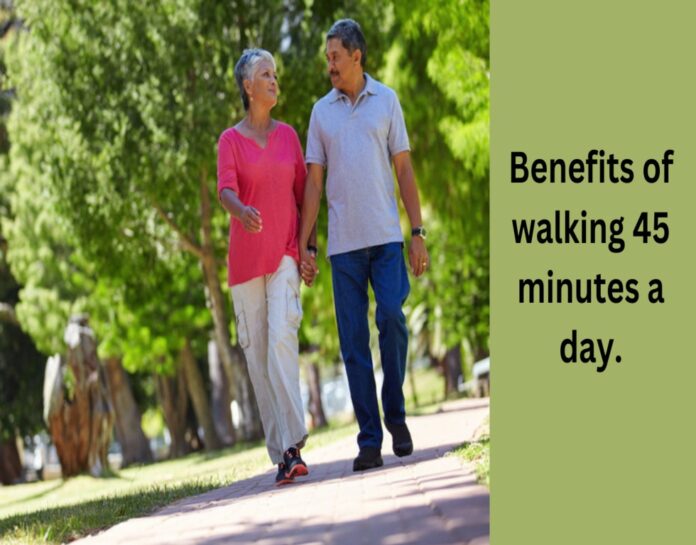In a world where sedentary lifestyles dominate, the simple act of walking often gets overlooked. However, walking is one of the most accessible forms of exercise, with numerous benefits for weight loss and overall well-being. Benefits of walking 45 minutes a day.
From enhancing cardiovascular health to boosting mood, the benefits of regular walking are abundant.
In this article, we’ll explore how incorporating daily walks into your routine can lead to significant weight loss, how to manage walking into your daily schedule, precautions to consider, and the importance of this simple yet powerful activity.
The Benefits of Walking for Weight Loss: Benefits of walking 45 minutes a day.

Walking might seem like a leisurely activity, but it can be an effective tool for weight loss when done consistently. Here’s how:
Calorie Burn: Walking burns calories, contributing to a calorie deficit necessary for weight loss. The number of calories burned depends on factors like speed, distance, and body weight.
Boosts Metabolism: Regular walking can increase your metabolism, helping you burn more calories throughout the day even when you’re not exercising.
Muscle Activation: Walking engages various muscle groups, including the legs, core, and even the arms if you swing them while walking briskly. This helps in toning muscles and improving overall body composition.
Reduces Belly Fat: Walking, especially at a brisk pace, targets visceral fat—the deep belly fat linked to various health problems, including obesity and heart disease.
Stress Reduction: Stress can contribute to weight gain through emotional eating and hormonal imbalances. Walking releases endorphins, which reduce stress and can help curb cravings.
Managing Daily Walking: Benefits of walking 45 minutes a day.
Incorporating walking into your daily routine doesn’t have to be complicated. Here are some tips for managing daily walks:
Schedule Walks: Treat your daily walks like appointments. Set aside specific times in your day dedicated to walking, whether it’s early morning, during your lunch break, or in the evening.
Start Small: If you’re new to walking for exercise, start with short walks and gradually increase the duration and intensity as your fitness improves.
Make it Enjoyable: Choose scenic routes, listen to music or podcasts, or walk with a friend or pet to make your walks more enjoyable and sustainable.
Incorporate Walking into Daily Tasks: Whenever possible, choose walking over driving or taking the elevator. Opt for stairs instead of escalators, and consider walking or biking for short errands.
Track Your Progress: Use a fitness tracker or smartphone app to monitor your steps, distance, and calorie burn. Seeing your progress can be motivating and help you stay consistent.
Precautions for Daily Walking: Benefits of walking 45 minutes a day.
While walking is generally safe for most people, there are some precautions to consider:
Proper Footwear: Invest in a good pair of walking shoes with adequate support and cushioning to prevent injuries and discomfort.
Warm-up: Before starting your walk, spend a few minutes warming up with dynamic stretches to prepare your muscles and joints.
Hydration: Stay hydrated before, during, and after your walk, especially in hot weather or during longer walks.
Sun Protection: If walking outdoors, wear sunscreen, sunglasses, and a hat to protect your skin and eyes from the sun’s harmful rays.
Listen to Your Body: Pay attention to how your body feels during walks. If you experience pain, dizziness, or other discomfort, stop and rest or seek medical attention if necessary.
The Importance of Walking: Benefits of walking 45 minutes a day.
Beyond weight loss, walking offers numerous health benefits:
Heart Health: Walking improves cardiovascular health by lowering blood pressure, cholesterol levels, and reducing the risk of heart disease and stroke.
Mental Well-being: Regular walking can alleviate symptoms of depression and anxiety, improve mood, and enhance cognitive function.
Bone Health: Weight-bearing activities like walking help strengthen bones, reducing the risk of osteoporosis and fractures.
Longevity: Studies have shown that regular walking is associated with a longer lifespan, as it helps maintain overall health and mobility into old age.
Diseases Prevented or Managed through Walking: Benefits of walking 45 minutes a day.
The benefits of walking extend beyond weight loss and encompass the prevention and management of various diseases, including:
Type 2 Diabetes: Walking helps regulate blood sugar levels, reducing the risk of developing type 2 diabetes and improving glycemic control in those already diagnosed.
Obesity: Regular walking, combined with a balanced diet, is an effective strategy for preventing and managing obesity.
Arthritis: Walking strengthens muscles around the joints, improves flexibility, and reduces pain and stiffness associated with arthritis.
Cancer: Some studies suggest that regular physical activity, including walking, may reduce the risk of certain cancers, including breast and colon cancer.
Conclusion: Benefits of walking 45 minutes a day.
Walking is a simple yet powerful form of exercise that offers numerous benefits for weight loss, overall health, and well-being.
By incorporating daily walks into your routine, you can enjoy improved fitness, better mood, and a reduced risk of chronic diseases.
With proper planning, precautions, and consistency, walking can be a sustainable and enjoyable way to achieve your health and weight loss goals. So lace up your shoes, step outside, and start walking towards a healthier, happier you.
How much walking do I need to do to lose weight?
The amount of walking needed for weight loss varies depending on factors like your current weight, diet, and overall lifestyle. Generally, aim for at least 150 minutes of moderate-intensity aerobic activity, such as brisk walking, per week, according to your body need.
Can walking alone help me lose weight, or do I need to combine it with other exercises?
While walking alone can contribute to weight loss, combining it with other forms of exercise and adopting a healthy diet will likely yield better results. Strength training exercises can help build muscle mass, which can boost metabolism and enhance weight loss efforts.
Is it better to walk indoors on a treadmill or outdoors?
Both indoor treadmill walking and outdoor walking offer benefits. Treadmill walking provides convenience and allows you to control factors like speed and incline, while outdoor walking exposes you to fresh air, nature, and varied terrain. Choose the option that fits your preferences and lifestyle best.
How can I stay motivated to walk regularly?
Setting specific goals, varying your walking routes, tracking your progress, and finding a walking buddy or joining a walking group can help keep you motivated. Additionally, reminding yourself of the health benefits and how good you feel after a walk can serve as motivation.
Is it safe to walk alone, especially in the early morning or evening?
While walking alone can be safe, especially in familiar and well-lit areas, it’s essential to prioritize personal safety. Choose well-populated routes, let someone know your walking route and estimated return time, and consider carrying a personal safety device or walking with a friend or pet for added security.
How can I prevent or manage blisters and foot pain from walking?
Wearing properly fitting, supportive shoes and moisture-wicking socks can help prevent blisters and foot pain. Gradually increasing your walking distance and intensity can also allow your feet to adjust gradually. If you experience persistent foot pain, consult a healthcare professional.
Can walking help me lose belly fat specifically?
Yes, walking, especially at a brisk pace, can help reduce belly fat by targeting visceral fat—the deep abdominal fat associated with various health risks. Combined with a healthy diet, regular walking can contribute to overall weight loss, including fat loss around the abdomen.
Are there specific times of the day that are best for walking?
The best time to walk depends on your schedule and personal preferences. Some people prefer walking in the morning to start their day energized, while others enjoy evening walks to unwind. Choose a time that works best for you and fits into your daily routine consistently.
How can I make my walking sessions more challenging as I progress?
Increasing your walking speed, incorporating intervals of brisk walking or incline walking, adding resistance with ankle weights or walking poles, and gradually increasing your walking distance or duration are all ways to make your walking workouts more challenging as you progress.
Can walking help improve my posture?
Yes, walking with proper posture—head up, shoulders back, and core engaged—can help strengthen muscles that support good posture. Incorporating exercises to strengthen your core, back, and hip muscles can further enhance posture and balance.





[…] by defining your objectives. Do you aim to lose weight, build muscle, enhance flexibility, or simply improve overall health? Setting specific, achievable […]
[…] to sleep better at night naturally ? Steps to Achieve Natural […]